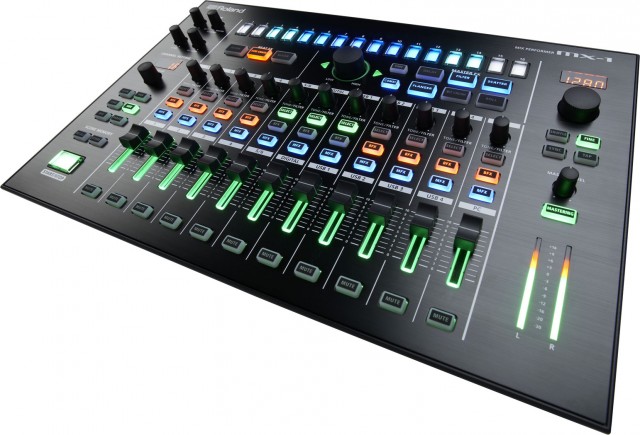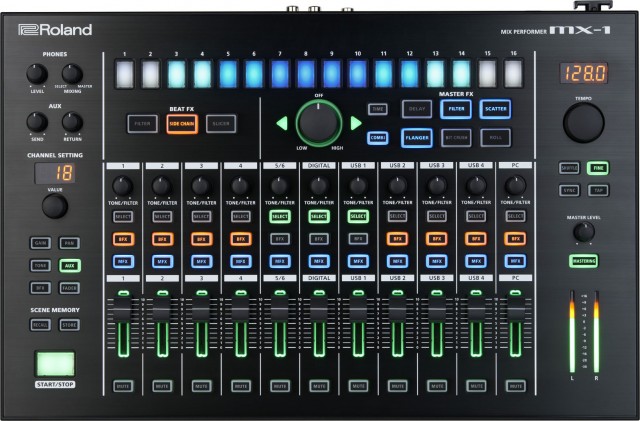So, now you’ve got a lot of hardware.
You’ve moved beyond just a computer, and you’re back to the joy of making music with boxes with knobs and faders and keys. And you’re playing with them live. And maybe Roland’s AIRA had something to do with that, too.
Now, how do you put them together?
KORG’s SQ-1 step sequencer is one answer. And Roland has provided the next chapter to its AIRA hardware saga with a mixer, its sixth product in the AIRA line.
But this isn’t just a way of connecting all the audio outputs from those devices – finding mixers, after all, isn’t hard to do. Roland wants to go one step further, and have you think of that mixer as an instrument to play, too.
The MX-1 is more than just a live-savvy mixer: it’s a computer interface, it’s a way to connect AIRA audio and MIDI with just USB cables even without a computer, and a tempo-synced multi-effects box.
For starters, you can take audio from different sources:
Your computer: Up to 18 channels of audio come from your computer, via USB.
Your AIRAs: You can also plug in Roland AIRA devices via USB – so you can connect a TR-8, TB-3, or SYSTEM-1, with both 96 kHz audio transfer and MIDI tempo sync — over the same USB cable. (Yes, this is a USB host feature. Sadly, it’s AIRA-only – too bad that USB vendors aren’t making this work in a standard way. Cough.)
Your other synths and drum machines and things. Analog inputs cover all your other gear. There’s even a single coax digital jack that’s either an input or output.
Outboard effects. Here’s the thing they might have forgotten – but didn’t. There are stereo send/return jacks for adding external effects units, too. (Eventide, anyone?)
For connectivity, the AIRA MX-1 is a mixed bag. Whereas the other integration product in the AIRA line – last year’s sync box – played nicely with any gear you own, the MX-1 is a bit shy on inputs apart from the AIRA and computer interface. So you get four USB ins, but they’re AIRA-only. The reason: AIRA hardware isn’t class-compliant, so these USB host ports can’t work with other gear. Those computer audio inputs are handy, but also assume the rest of the features on option are desirable.
The remaining analog options: 1 stereo minijack, plus 4 mono audio jacks. That’s not a whole lot of inputs for a mixer this big, but it might be enough – especially if at least one piece of kit you’re connecting is an AIRA. (See specs below.)
That brings us on to the other AIRA MX-1 features….
The other reason to look at the MX-1 is that this is finally a mixer that’s been geared for live use, not studio use. The mixers have controls and customization that make them easier to “play” live, you can set up scenes for live use, and you get tempo-synced, step sequencer effects (if you’re into that sort of thing).
The mixer strips themselves look capable: you can choose up to six volume curves for the fader, adjust with a Tone/Filter knob, and mute. (Tone and Filter replace more conventional options like a 3-band EQ.) For once, the blind-your-eyes LED colors of an AIRA unit might be genuinely useful: the LED-lit faders light up or dim based on the mute settings.
And yes, there’s a DJ-style cue feature. That might be the most useful thing on here – you can finally see if that groove on your synth is about to wreck the sound of your set without, you know, also trying it on the audience.
Ripe for abuse (or loving abuse), there are also loads of tempo-synced effects. This will either make the MX-1 a must-buy, or annoy the hell out of you when someone goes nuts with it, or both. You get channel-independent Beat FX (Filter, Side Chain, and Slicer), plus Master FX such as Scatter, Roll, Bit Crush, and others. Because EDM.
Interesting: the master effects can’t be routed independently to tracks, but they can – mercifully – be disabled per track. What appears to be missing is something like reverb, but I’m looking up full specs.
I’m a little dubious about the effects, to be honest – they’ve never been a favorite part of a Roland box for me. But even if the effects are a complete disaster, this is still looking like a compelling box.
Look at it this way: you can now connect a computer and/or gear and/or outboard effects and/or AIRAs with a minimum number of cables, then get performance-style mix and tone controls over them, and DJ cueing. Without the AIRAs, there just isn’t much here – but with even one AIRA, this starts to get interesting.
Ironically, that might mean that, for all the MX-1’s computer connectivity options, it’s even easier to leave the computer at home.
Yes, we’ll review this soon. (And while we wait, I’ll talk to the product folks, so fire away with any questions.)
Specs:
Tempo – 40-300 bpm
16×4 memory
Beat Effects: 5 types of filter, 5 types of sidechain, 5 times of slicer, 8 types of master FX delay, 8 types of filter, 8 types of scatter, 8 types of flanger, 8 types of bit crush, 8 types of roll
USB audio interface: 18 channels input, 18-channels output Note this – it appears the MX-1 also works as a perfect audio interface for recording. You’ll want that computer, it seems.
Outputs: headphone (stereo jack), stereo mix out (mono jack)
Analog inputs
1-4 : mono 1/4″ jacks
5-6: Stereo minijack Roland intends this for your iPhone, iPad, etc. – though this also covers the – cough – KORG volca series and MeeBlip, among others
Sends/returns
RCA phono (cinch) aux return (single L/R right)
RCA phono (cinch) aux send (single L/R pair)
Digital I/O
USB HOST 1-4 ports for your AIRAs (TB-3/VT-3/TR-8/SYSTEM-1 only, say Roland)
Note that these carry audio and MIDI, though only port 3 has USB bus power, so don’t forget your PSUs.
Coax in/out jack
MIDI in, out connectors (guess this is for running clock in or out over MIDI DIN?)
Dimensions
400 mm x 264 mm x 65 mm, 1.81 kg (four pounds – though Roland labels it 3 lb., 16 oz., which… is exactly four pounds, think they mean 15 oz.)
Videos
It shoots lasers.



